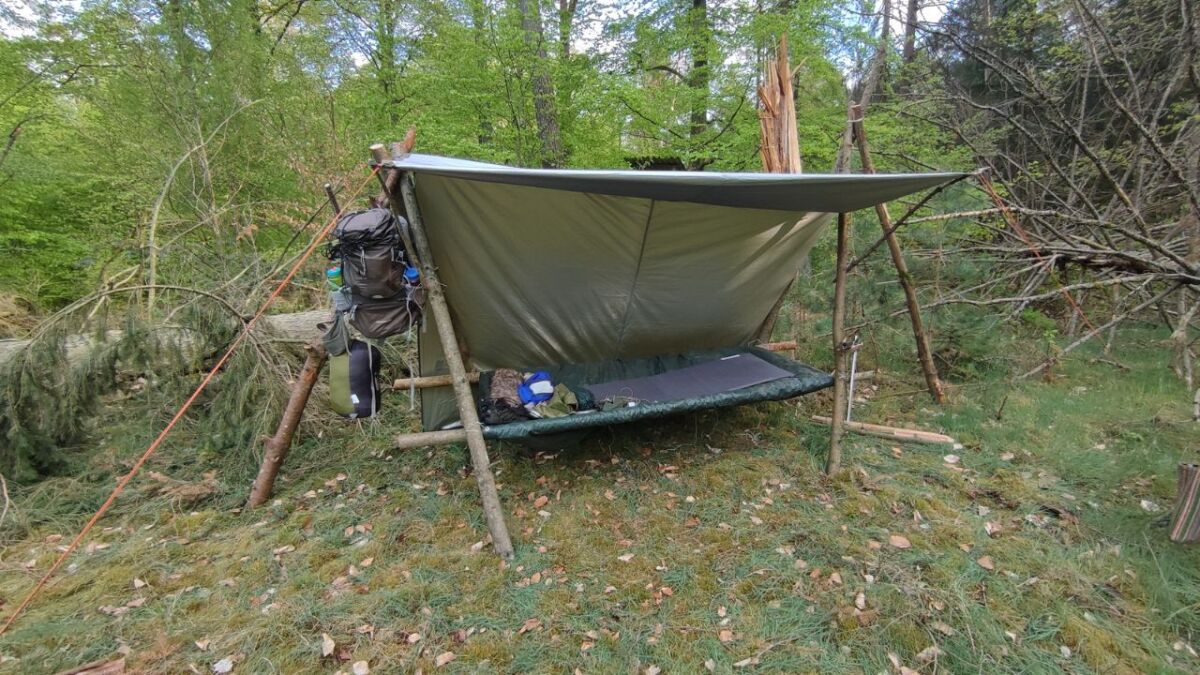
bed
Nomen
Meaning
A bed is a crucial element in the world of survival, bushcraft, and outdoor activities. It provides a comfortable and safe place to rest and sleep, ensuring that you are well-rested and ready for the challenges of the wilderness. In camping, hiking, and survival situations, a bed can be improvised using natural materials such as leaves, branches, or animal hides. It is important to create a bed that is insulated from the ground to prevent heat loss and provide cushioning. A well-made bed can significantly improve your comfort and overall well-being in the outdoors.

Examples
„I love sleeping in my cozy bed after a long day of hiking and exploring the wilderness.“
„When you're out in the wild, finding a comfortable bed can be a challenge, but with some creativity and resourcefulness, you can create a makeshift bed using branches and leaves.“
„During my survival training, I learned how to make a bed out of natural materials like grass and moss. It may not be as comfortable as a regular bed, but it provides insulation and keeps you off the cold ground.“
„In a survival situation, finding a dry and safe place to set up your bed is crucial for a good night's sleep.“
„When camping in the wilderness, it's important to choose a suitable spot for your bed, away from potential hazards like falling branches or uneven ground.“
Origin
The word "bed" originates from the Old English word "bedd", which can be traced back to the Proto-Germanic word "badjam". This word has its roots in the Proto-Indo-European word "bhedh-", meaning "to dig" or "to make a hole".
Throughout history, the concept of a bed has evolved and varied across different cultures. In ancient times, beds were often simple mats or piles of straw or leaves. As societies developed, beds became more elaborate and comfortable, with the use of frames, mattresses, and bedding.
In modern times, beds have become an essential piece of furniture in households around the world. They are designed for comfort and relaxation, providing a place to sleep and rest. Beds come in various sizes and styles, ranging from single beds to king-size beds, and can be made from different materials such as wood, metal, or upholstered fabric.
Whether it's a cozy camping bed in the wilderness or a luxurious bed in a five-star hotel, the concept of a bed remains a fundamental part of human life, offering a place to rest, rejuvenate, and dream.
Synonyms
Couch, Mattress, Sleeping surface, Cot, Bunk, Pallet, Futon, Divan
Antonyms
Awake, Rise, Get up, Stand, Wake, Arise, Awaken, Rouse
Relatives
Sleep, Mattress, Rest, Bedroom, Nap, Dream, Pillow, Insomnia
Historical and cultural importance
The word "bed" has a significant historical and cultural relevance. Throughout history, the concept of a bed has evolved and varied across different cultures. In ancient civilizations, such as Egypt and Rome, beds were considered a symbol of wealth and status. They were often ornately decorated and reserved for the elite. In medieval Europe, beds were typically simple and consisted of a wooden frame with a straw-filled mattress. They were often shared by multiple family members and even livestock. During the Renaissance period, beds became more luxurious and were adorned with elaborate canopies and curtains.
In modern times, the bed has become an essential piece of furniture in every household. It is a place of rest and relaxation, providing comfort and support for a good night's sleep. Beds come in various styles and sizes, ranging from traditional four-poster beds to contemporary platform beds. The design and materials used in bed construction have also evolved, with advancements in technology and comfort. Today, beds are not only functional but also serve as a statement piece in interior design.
Furthermore, the cultural significance of the bed extends beyond its physical form. It is often associated with concepts of comfort, intimacy, and personal space. The phrase "making the bed" is a common household chore that symbolizes tidiness and order. Additionally, the bed is often depicted in literature, art, and film as a symbol of rest, dreams, and even romance. Overall, the historical and cultural relevance of the bed highlights its importance in human civilization and the significance it holds in our daily lives.
More information about the term bed
Bed
A bed is an essential item for any survivalist or outdoor enthusiast. It provides a comfortable and safe place to rest and sleep, allowing you to recharge your energy for the challenges that lie ahead. In the wilderness, where conditions can be harsh and unpredictable, having a reliable bed is crucial for your well-being.
Types of Beds
There are several types of beds that you can use in a survival or outdoor setting:
1. Sleeping Bag: A sleeping bag is a portable and lightweight bed option. It consists of a zippered bag that you can crawl into, providing insulation and protection from the elements. Sleeping bags are easy to pack and carry, making them ideal for backpacking or camping trips.
2. Hammock: A hammock is a suspended bed made of fabric or netting. It is typically attached to two trees or other sturdy anchor points. Hammocks are great for camping in areas with limited ground space or uneven terrain. They offer a comfortable and elevated sleeping position, away from damp or rocky ground.
3. Bivy Sack: A bivy sack, also known as a bivouac sack, is a waterproof and breathable shelter that encloses your sleeping bag. It provides an extra layer of protection against rain, wind, and insects. Bivy sacks are compact and lightweight, making them suitable for minimalist camping or emergency situations.
Considerations for Choosing a Bed
When selecting a bed for your outdoor adventures, there are a few factors to consider:
1. Comfort: Look for a bed that offers adequate cushioning and support for a good night's sleep. Consider your personal preferences and any specific needs, such as back support or insulation.
2. Portability: Depending on your activities, you may need a bed that is easy to carry and pack. Sleeping bags and bivy sacks are typically more portable than hammocks, which require additional suspension systems.
3. Durability: Your bed should be able to withstand the rigors of outdoor use. Look for materials that are tear-resistant, waterproof, and durable. Reinforced stitching and quality construction are also important for longevity.
Bed Maintenance
To ensure the longevity and performance of your bed, proper maintenance is essential:
1. Cleaning: Regularly clean your bed according to the manufacturer's instructions. This may involve hand washing, machine washing, or spot cleaning. Keeping your bed clean will help prevent odors and extend its lifespan.
2. Storage: When not in use, store your bed in a dry and well-ventilated area. Avoid prolonged exposure to direct sunlight, as it can cause fading and deterioration of materials.
3. Repairs: Promptly address any damages or wear and tear on your bed. Patch up small holes or tears to prevent further damage. Replace any broken or worn-out components, such as zippers or suspension cords.
Remember, a good bed is an investment in your comfort and well-being during your outdoor adventures. Choose wisely, maintain it properly, and enjoy a good night's sleep under the stars.
Back to overview

